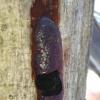
17-01-2026 19:35
Arnold BüschlenHallo, ich suche zu Cosmospora aurantiicola Lite

08-12-2025 17:37
 Lothar Krieglsteiner
Lothar Krieglsteiner
20.6.25, on branch of Abies infected and thickened

16-01-2026 00:45
Ethan CrensonHi all, On decorticated hardwood from a New York

10-01-2026 20:00
Tom SchrierHi all,We found picnidia on Protoparmeliopsis mur

13-01-2026 07:28
 Danny Newman
Danny Newman
Chlorociboria glauca on indet. decorticate logThe

15-01-2026 15:55
 Lothar Krieglsteiner
Lothar Krieglsteiner
this one is especially interesting for me because

13-01-2026 08:43
 Danny Newman
Danny Newman
Tricladium varicosporioides on indet. decorticate
Which Xylariaceae?
Garrett Taylor,
27-12-2019 05:59
Q = (2.1) 2.4 - 3 (3.3) ; N = 35
Me = 12.4 × 4.6 µm ; Qe = 2.7
Jacques Fournier,
27-12-2019 12:07

Re : Which Xylariaceae?
Hi Garrett,
your fungus is suggestive of Pyrenomyxa, a genus revised in 2005 by Stadler et al., Mycologia 97(5): 1129-1139.
Two of the three species could match your find, P. picea and P. morganii, more likely the former because of the apparently orange brown colour of the stroma shown by your photo.
If you check the paper you should get to a more reliable identification.
Cheers,
Jacques
Garrett Taylor,
28-12-2019 05:37
Re : Which Xylariaceae?
Thanks so much, Jacques! After reading the material you suggested, it does appear your intuition that this is Pyrenomyxa picea (Ellis) M. Stadler, Læssøe & Lar. N. Vassiljeva, comb. nov. is correct in this instance. The spores here are slightly larger than reported, but this was a fresh specimen.
P. morganii has only been collected in Eastern Russia. It's KOH-extractable pigments are all of the colors, even purple after a time.
P. invocans is also reddish brown and also found near me, but it's KOH-extractable pigments are orange, not green.
This isn't the first time for me finding this Genus, so it feels extra great to know what it is!
*I edited the spore size as I truncated the first part of the length measurment originally.
P. morganii has only been collected in Eastern Russia. It's KOH-extractable pigments are all of the colors, even purple after a time.
P. invocans is also reddish brown and also found near me, but it's KOH-extractable pigments are orange, not green.
This isn't the first time for me finding this Genus, so it feels extra great to know what it is!
*I edited the spore size as I truncated the first part of the length measurment originally.
Jacques Fournier,
28-12-2019 16:33

Re : Which Xylariaceae?
Thanks for our enthusiastic answer Garrett.
Actually I just know Pyrenomyxa from literature and I do not expect to find it in Western Europe.
Actually I just know Pyrenomyxa from literature and I do not expect to find it in Western Europe.
I you ever come across some material in good condition again, I would be very grateful if you can send me a sample, gently air-dried, wrapped in paper and posted by ordinary mail.
Thanks a lot!
Jacques
Garrett Taylor,
29-12-2019 04:45
Re : Which Xylariaceae?
There are a few of them on that log that looked like they were in nice shape, if you send me your address I will glady try to see if I can get some off in one piece and send a sample along. My email is taygamu at gmail.com





